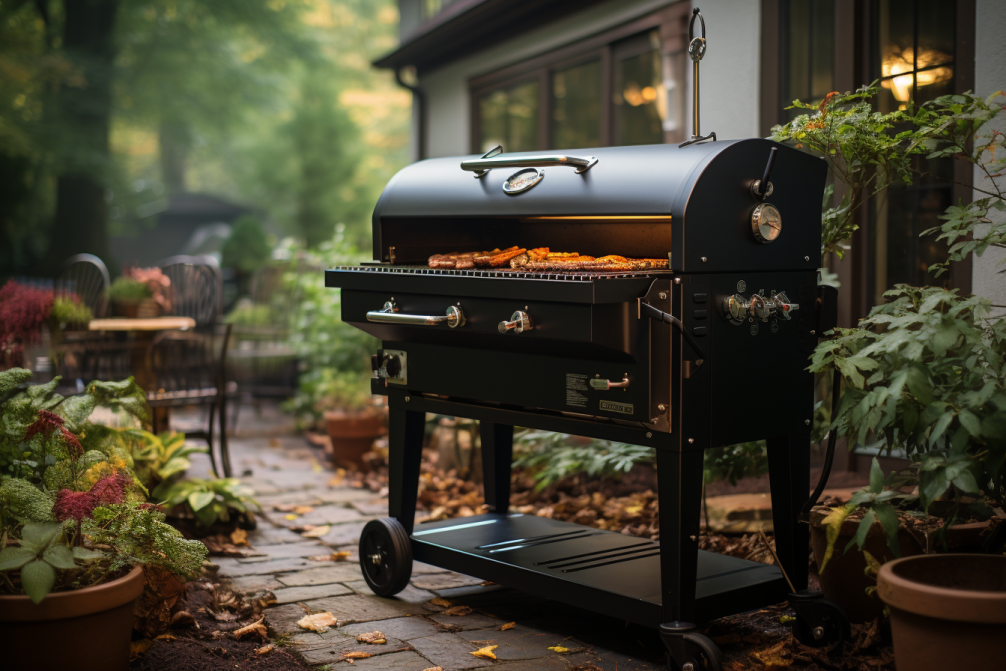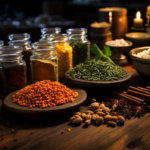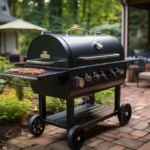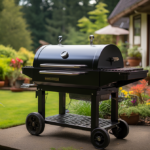Table of Contents
Masters of the Grill: Unleash Your Inner Grillmaster and Outshine the Competition
Hey there, grill enthusiasts! Are you ready to take your backyard BBQ game to a whole new level? It’s time to kick those mediocre burgers and boring hot dogs to the curb and step up your grilling skills like never before. Say hello to the ultimate guide that will turn you into a competition-level grilling superstar!
We all know that feeling of hosting a summer cookout and watching others gobble up their food with pure delight. But deep down, we’ve always wondered: how do those competition pitmasters achieve such mind-blowing flavors and that perfect smoky tenderness? Well, wonder no more, because we’re about to spill all the secrets in this guide.
From selecting the right cuts of meat to mastering the art of creating mouthwatering marinades and rubs, we’ve got you covered. We’ll dive into different grilling techniques, whether it’s the classic charcoal method, embracing the convenience of gas grills, or exploring the wonders of pellet smokers. We’ll also reveal the importance of temperature control, smoking times, and the science behind creating that coveted smoke ring.
But it’s not just about the cooking techniques – we’ll also show you how to elevate your dishes with killer side dishes, delectable sauces, and even out-of-this-world desserts. Get ready to wow your guests, impress your friends, and smoke out the competition at your next cook-off.
So, grab your apron, fire up the grill, and let’s dive headfirst into the world of competition-level grilling. Get ready to take your backyard barbecues from average to extraordinary!
Mastering the Art of Low and Slow Cooking
Grilling isn’t just about quickly searing a piece of meat over high heat. It’s about taking your time, letting the flavors develop, and achieving that tender, melt-in-your-mouth goodness that competition grilling is known for. And to do that, you need to master the art of low and slow cooking. Here are the essential aspects you need to know:
- Choosing the right cuts: When it comes to low and slow cooking, not all cuts of meat are created equal. Look for tougher cuts, like beef brisket, pork shoulder, and ribs, that benefit from the long cooking process.
- Preparing the meat: Before you even think about firing up the grill, proper preparation is key. Trim excess fat, apply a flavorful rub, and let the meat marinate overnight to enhance its tenderness and taste.
- Setting the temperature: Low and slow means cooking at a lower temperature for an extended period. Aim for a temperature range between 225°F and 275°F (107°C to 135°C), depending on the cut of meat. Invest in a reliable thermometer to ensure accuracy.
- Indirect heat and smoke: To achieve that delectable smoky flavor, use indirect heat. Place the meat away from the direct flame or heat source, allowing the smoke to circulate around it. Experiment with different wood chips, like hickory, apple, or mesquite, to create unique flavor profiles.
- Patience is a virtue: Low and slow cooking requires patience. This method can take several hours, even upwards of 12 hours, depending on the size and type of meat. Stay vigilant with temperature monitoring, periodically checking on the meat, and resisting the urge to rush the process.
- The power of resting: Once the meat is cooked to perfection, resist the temptation to dig in right away. Resting the meat allows the juices to redistribute, ensuring every bite is juicy and tender. Tent the meat with foil and let it rest for at least 15 to 30 minutes before slicing.
Mastering the art of low and slow cooking is a game-changer in competition-level grilling. It requires attention to detail, patience, and a commitment to achieving incredible flavors and textures. So, get those smokers fired up and be ready to wow the competition with your perfectly cooked, mouthwatering barbecue creations.
Choosing the Perfect Cuts of Meat for Competition Success
When it comes to competition-level grilling, the choice of meat can make or break your chances of winning over the judges’ taste buds. Here are the essential aspects to consider when choosing the perfect cuts of meat for competition success:
- Beef Brisket: Known as the king of competition cuts, beef brisket demands skill and patience. Look for a well-marbled, USDA Prime or Choice grade brisket with a thick flat. The fat content will render down during the cooking process, creating that juicy and tender texture that earns high scores.
- Pork Shoulder: Also referred to as pork butt or Boston butt, this cut is ideal for succulent pulled pork. Opt for a bone-in shoulder, preferably with a good layer of fat cap. The collagen in the fat breaks down during the long cooking time, resulting in luscious, flavorful meat.
- Ribs: St. Louis-style spare ribs or baby back ribs are popular choices in competitions. St. Louis-style ribs are meatier and have a slightly higher fat content, while baby back ribs are leaner and cook faster. Look for ribs with consistent marbling and a good meat-to-bone ratio.
- Chicken: Competition grilling often involves chicken thighs or whole chickens. Thighs are preferred for their juiciness and flavor. Choose bone-in, skin-on thighs with even thickness and a good amount of fat. If using whole chickens, ensure they are small and not too large to cook evenly.
- Lamb: For those seeking a unique edge in competitions, lamb can be a showstopper. Opt for well-marbled lamb racks or bone-in leg of lamb. The rich, distinct flavor of lamb can impress the judges and set your entry apart from the traditional beef and pork options.
Remember, the quality of the meat is crucial. Seek out reputable butchers or reliable sources to ensure you’re starting with the best possible ingredients. Additionally, proper handling and storage are essential to maintain freshness and flavor. Keep the meat refrigerated until you’re ready to prep and cook it.
By choosing the perfect cuts of meat and mastering their preparation, you’ll be well on your way to competition-level grilling success. So, fire up those smokers, elevate your flavors, and get ready to smoke out the competition with your outstanding barbecue prowess.
Creating Flavorful Marinades and Rubs that Set You Apart
One of the secrets to competition-level grilling is the ability to infuse your meat with mouthwatering flavors that leave a lasting impression on the judges’ taste buds. Here are the essential aspects of creating flavorful marinades and rubs that will set you apart:
- Marinades: Marinades are a great way to add flavor and tenderness to your meat. Here’s how to create a winning marinade:
- Start with an acidic component like citrus juice, vinegar, or a combination of both. This helps break down the meat’s fibers and enhance its flavor.
- Add some oil to the marinade, such as olive oil or vegetable oil. This helps keep the meat moist and prevents it from sticking to the grill.
- Experiment with a variety of herbs and spices, including garlic, ginger, herbs like rosemary or thyme, and a mix of your favorite spices to create a unique flavor profile.
- Don’t forget a touch of sweetness with ingredients like honey, maple syrup, or brown sugar to balance out the flavors.
- Rubs: Rubs are dry mixtures of herbs, spices, and other seasonings that are applied directly to the meat before grilling. Here’s how to create a winning rub:
- Start with a base of salt and pepper to enhance the natural flavors of the meat.
- Add a selection of spices and herbs like paprika, cumin, chili powder, garlic powder, onion powder, or dried herbs like thyme or oregano. Be bold and experiment with different combinations to find your signature rub.
- Consider adding a touch of sweetness with ingredients like brown sugar or granulated honey to create a delightful caramelized crust on the meat.
- For an extra kick, incorporate some heat with cayenne pepper, crushed red pepper flakes, or your favorite hot sauce.
Remember to let your marinades work their magic by allowing the meat to marinate for an adequate amount of time. For rubs, apply them generously, ensuring all sides of the meat are evenly coated.
Creating flavorful marinades and rubs is an art that can elevate your grilling game to competition level. So, let your creativity run wild, experiment with different ingredients, and don’t be afraid to take risks. With the right combination of flavors, you’ll be well on your way to standing out from the competition and impressing the taste buds of the judges.
No products found.
Exploring Different Grilling Techniques: Charcoal, Gas, or Pellet Smokers
When it comes to competition-level grilling, using the right grilling technique can make a world of difference in the flavors and textures you achieve. Let’s dive into the essential aspects of the three most popular grilling techniques: charcoal, gas, and pellet smokers.
- Charcoal Grilling: Charcoal grilling is a classic method that offers a distinct smoky flavor and an authentic grilling experience. Here’s what you need to know:
- Use natural lump charcoal or high-quality briquettes for better heat control and flavor.
- Arrange the charcoals in a two-zone setup, with one side having the coals for direct high-heat grilling and the other side for indirect low-and-slow cooking.
- Enhance the smoky flavor by using wood chips or chunks soaked in water and added directly to the charcoal.
- Gas Grilling: Gas grills are known for their convenience and quick startup. Here are some tips for mastering gas grilling:
- Preheat the grill by turning it on and letting it heat up for a few minutes before placing the food on the grates.
- Utilize the multiple burners to create different heat zones, allowing you to control the heat levels for different cooking techniques.
- Add flavor to your food by using smoker boxes or aluminum foil packets filled with wood chips placed on the grill grates to create smoke.
- Pellet Smokers: Pellet smokers combine the convenience of gas grills with the flavor of charcoal grills. Here’s how to make the most of your pellet smoker:
- Fill the hopper with wood pellets of your choice, such as mesquite, hickory, or fruitwood varieties, to infuse the meat with smoky flavors.
- Set the desired temperature on the control panel, and the smoker will automatically feed the pellets and maintain the temperature throughout the cooking process.
- Experiment with different wood pellet flavors to create unique and nuanced smoky profiles.
Each grilling technique has its pros and cons, so choose the one that aligns with your preferences and the flavors you want to achieve. Whether you prefer the traditional smoky flavor imparted by charcoal, the convenience of gas grilling, or the versatility of pellet smokers, mastering the technique will bring you one step closer to competition-level grilling mastery. So, fire up your grill of choice and get ready to wow the judges with your outstanding grilling skills.
No products found.
The Science of Smoke: Achieving that Enviable Smoke Ring
One of the hallmarks of competition-level grilling is achieving that beautiful, pinkish smoke ring around the meat. It’s not just visually appealing but also a sign of tender, flavorful barbecue. Here’s a breakdown of the essential aspects and the science behind achieving that enviable smoke ring:
- What is the smoke ring?: The smoke ring is a pink layer that forms on the outer edges of smoked meats, like brisket or pork. It’s a reaction between the smoke, meat proteins, and the natural myoglobin in the meat. The smoke ring is a result of the combustion gases, particularly nitrogen dioxide, binding with the myoglobin, creating that distinctive pink hue.
- The role of low and slow cooking: Achieving a smoke ring is closely tied to low and slow cooking. The longer cooking times allow more smoke to penetrate the meat, increasing the chances of a significant smoke ring.
- Choosing the right wood: Different types of wood produce different levels of smoke and flavor. Hardwoods like oak, hickory, or mesquite are popular choices for creating a robust smoke ring. Experiment with various wood varieties to find the flavor profile that suits your taste.
- Keeping the temperature low: To maximize the smoke ring formation, maintain a lower cooking temperature. The ideal range is around 225°F to 250°F (107°C to 121°C). This prolonged exposure to lower temperatures ensures a more pronounced smoke ring.
- Patience and timing: Remember, achieving a notable smoke ring takes time. Be patient and resist the temptation to rush. Allow the meat to absorb the smoke for several hours, depending on its size and the intensity of smoke you desire.
- Slicing for presentation: Once your meat is cooked to perfection and boasts a beautiful smoke ring, it’s time to slice it for presentation. Cut the meat perpendicular to the smoke ring to showcase it prominently. Each bite will be a stunning visual and flavorful delight.
Understanding the science behind achieving a smoke ring can take your competition-level grilling to the next level. With the right combination of low and slow cooking, choice of wood, and attention to detail, you’ll impress the judges with your enviable smoke ring. So, fire up your smoker, let the smoke work its magic, and get ready to dazzle both visually and gastronomically.
The Importance of Temperature Control and Smoking Times
When it comes to competition-level grilling, precise temperature control and smoking times can make all the difference in achieving perfectly cooked, tender, and flavorful meat. Here are the essential aspects to consider:
- Temperature control: Maintaining a consistent temperature throughout the cooking process is crucial for even cooking and desired levels of tenderness. Here’s what you need to know:
- Invest in a reliable meat thermometer to accurately monitor the internal temperature of the meat.
- Use the vents on your grill or smoker to control the airflow and maintain the desired temperature.
- Experiment with different temperature ranges for different cuts of meat and cooking techniques. Low and slow cooking typically ranges from 225°F to 275°F (107°C to 135°C).
- Smoking times: Determining the cooking time is essential to achieve the perfect balance of smoke flavor and tenderness. Here are some tips to help you navigate smoking times:
- Consider the size and thickness of the meat when estimating smoking times. Thicker cuts will require more time for the smoke to penetrate and cook evenly.
- Research the recommended smoking times for specific cuts of meat, but remember that these times are guidelines. Each cut and smoker setup may have slight variations.
- Use a combination of time and temperature monitoring to ensure the meat is cooked to the desired doneness. The internal temperature, as indicated by the thermometer, is a more reliable indicator of doneness than a set cooking time.
- Resting period: After the meat is cooked to perfection, don’t skip the resting period. Allowing the meat to rest before serving is crucial for retaining its juices and ensuring optimal tenderness. Rest the meat, covered with foil, for around 15 to 30 minutes before slicing and serving.
Remember, competition-level grilling requires precision, attention to detail, and a good understanding of temperature control and smoking times. By mastering these aspects, you’ll be able to achieve consistent, delicious results that set you apart from the competition. So, keep an eye on the temperature, plan your smoking times accordingly, and get ready to wow the judges with your perfectly cooked, mouthwatering creations.
Side Dishes that Complement Your Grilled Masterpieces
When it comes to competition-level grilling, it’s not just about the main attraction – the side dishes play a crucial role in completing the dining experience and impressing the judges. Here are some essential aspects to consider when choosing side dishes that will complement your grilled masterpieces:
- Balance of flavors: Look for side dishes that provide a balance of flavors to complement the richness and smokiness of your grilled meats. Consider dishes that offer contrasting tastes, such as tangy, sweet, or acidic flavors, to cut through the richness of the meats.
- Texture play: Texture is essential in creating a well-rounded meal. Choose side dishes that offer a variety of textures to add dimension to the plate. Crispy, crunchy, and creamy elements can elevate your overall dining experience.
- Fresh and seasonal ingredients: Opt for side dishes that showcase fresh, seasonal ingredients. Locally sourced vegetables and fruits can add vibrant colors, flavors, and nutritional value to your meal. Celebrate the bounties of the season and let the natural flavors shine.
- Complementary sauces and dips: Just as a great sauce can elevate a grilled masterpiece, the same goes for side dishes. Pair your sides with delicious, complementary sauces and dips. Consider options like homemade barbecue sauce, tangy vinaigrettes, creamy aioli, or flavorful salsas to enhance the overall taste.
- Global inspirations: Take your side dishes to another level by drawing inspiration from global cuisines. Whether it’s Mediterranean-inspired salads, Asian-inspired slaws, or Latin American-inspired grilled vegetables, incorporating different flavors and techniques can bring an exciting twist to your meal.
- Creative twists: Don’t be afraid to get creative and put your unique spin on classic side dishes. Think outside the box and experiment with unconventional ingredients or cooking methods to surprise and delight the judges.
Remember, side dishes are an opportunity to showcase your culinary creativity and elevate your overall grill game. With the right balance of flavors, textures, and fresh ingredients, your side dishes will complement your grilled masterpieces and take your competition-level grilling to new heights. So, get your creative juices flowing, explore new recipes, and enjoy the delicious journey of creating memorable meals.
Elevating your Barbecue Game with Delicious Homemade Sauces
No competition-level grilling experience is complete without a selection of delicious homemade sauces to amp up the flavors of your grilled masterpieces. Here are some essential aspects to consider when elevating your barbecue game with homemade sauces:
- Variety is key: Experiment with a variety of homemade sauces to cater to different tastes and complement a range of grilled meats. Consider options like tangy barbecue sauces, spicy sriracha-based sauces, sweet and savory glazes, or creamy aiolis. Having a variety of sauces on hand allows your guests or judges to customize their flavors according to their preferences.
- Balance of flavors: Achieve a well-balanced sauce by incorporating different flavor elements. Balance sweetness with acidity, and consider adding elements of tanginess, smokiness, heat, or earthiness for complex flavor profiles. Taste test as you go, adjusting the ingredients to achieve the desired balance.
- Quality ingredients: Use fresh, high-quality ingredients to ensure the best flavors in your homemade sauces. Choose ripe tomatoes for tomato-based sauces, fresh citrus for tangy marinades, and aromatic herbs and spices for added depth. Quality ingredients make a notable difference in the final taste of your sauces.
- Experiment with customization: While traditional barbecue sauces are great, don’t be afraid to put your own spin on them. Add unique ingredients like bourbon, honey, chipotle peppers, or even fruit preserves to create signature flavors that set you apart from the competition. Let your creativity shine through in your homemade sauces.
- Consistency and texture: Pay attention to the consistency and texture of your sauces. Some dishes benefit from a smooth and pourable sauce, while others call for a thick and sticky glaze. Use a blender or food processor to achieve the desired consistency, and consider straining the sauce to remove any lumps or fibers. Experiment with different thicknesses to find what works best for each sauce.
- Make ahead of time: Plan ahead and make your sauces in advance to allow the flavors to meld together. Many sauces taste even better after they’ve had time to sit and develop. Store them in airtight containers in the refrigerator, and give them a quick stir before using to ensure all the delicious flavors are evenly distributed.
By leveraging the power of homemade sauces, you can take your competition-level grilling to new heights. With a range of flavors, balance, and customization, your grilled masterpieces will be bursting with the perfect combination of tastes and elevate your barbecue game to the next level. So, grab your apron, gather your ingredients, and get ready to unleash the magic of homemade sauces on the judges’ taste buds.
Irresistible Desserts to End Your BBQ on a Sweet Note
No competition-level grilling experience is complete without a sweet ending to your BBQ feast. Impress the judges and leave your guests craving more with these irresistible homemade desserts. Here are some essential aspects to consider when choosing desserts that will end your BBQ on a sweet note:
- Grilled Fruit: Grilling fruit brings out their natural sweetness and adds a delicious charred flavor. Consider grilling pineapple slices, peaches, or watermelon wedges. Serve them as is or create a mouthwatering fruit salad or skewers. Top them with a drizzle of honey, a sprinkle of cinnamon, or a dollop of whipped cream for extra indulgence.
- S’mores: Take the beloved campfire treat to the next level by creating a s’mores station. Provide graham crackers, marshmallows, and chocolate bars for everyone to create their personalized s’mores. Use a portable grill or a fire pit to toast the marshmallows for that perfect gooey, melty delight.
- Grilled Dessert Pizzas: Get creative and put a sweet twist on the classic pizza. Grill individual pizza crusts until crispy, then top them with delicious dessert ingredients. Think Nutella and sliced strawberries, caramelized bananas and peanut butter, or even a combination of melted chocolate and toasted coconut.
- Frozen Treats: Keep your guests cool and satisfied with refreshing frozen treats. Homemade popsicles, ice cream sandwiches, or ice cream sundaes are all great options. Get creative with flavors, such as fruity combinations like strawberry-lemon or indulgent ones like cookies and cream.
- Cobblers and Crisps: Make use of seasonal fruits by preparing delightful cobblers or crisps. Top them with a buttery, crispy crumb topping, and let the fruit filling bubble away on the grill. Serve them warm with a scoop of vanilla ice cream or a dollop of whipped cream.
- Grilled Pound Cake or Brownies: Slice store-bought or homemade pound cake or brownies and lightly grill them for a smoky twist. Serve them warm with a drizzle of chocolate sauce, a scoop of ice cream, or fresh berries for a simple yet delightful dessert.
When it comes to dessert, let your creativity shine and choose options that showcase seasonal flavors, offer a variety of textures, and bring a delightful end to your BBQ experience. These irresistible desserts will satisfy any sweet tooth and ensure your competition-level grilling ends on a positively sweet note. So, fire up that grill, grab your dessert ingredients, and get ready to dazzle everyone with your delectable treats.
Conclusion
So there you have it, folks! With this guide to competition-level grilling, you’re equipped with the knowledge and skills to smoke out the competition and impress even the toughest judges. From mastering the art of low and slow cooking to creating flavorful marinades and rubs, exploring different grilling techniques, and elevating your BBQ game with homemade sauces, you’re now a true grillmaster.
Remember, competition-level grilling is about attention to detail, experimentation, and pushing the boundaries of flavor. Take the time to select the perfect cuts of meat, nail those smoking times, and control your temperatures like a pro. And don’t forget to wow with your sides, desserts, and homemade sauces, adding that extra pizzazz to your culinary creations.
So fire up your grills, embrace the aroma of smoky goodness, and let your BBQ skills shine. Whether you’re hosting a backyard cook-off or simply impressing your friends and family, this guide has your back. Now, it’s time to take your grilling game to the next level and leave a lasting impression with your competition-level skills. Happy grilling!









